 Playing with blocks doesn’t get old. All anyone needs to do is lookup Adult Fans of Lego and see some of the amazing work that modern LEGO brick artists/architects have created. The pleasure of three-dimensional mental planning and execution is almost universal.
Playing with blocks doesn’t get old. All anyone needs to do is lookup Adult Fans of Lego and see some of the amazing work that modern LEGO brick artists/architects have created. The pleasure of three-dimensional mental planning and execution is almost universal.
Readers who are familiar with the Catacombs product brand and the disc-flicking gameplay might be a bit surprised. Catacombs Cubes, a standalone game that, as far as this reviewer can tell, is the first game with a Catacombs name that does not feature an accuracy-based dexterity element. Rather, players are leaders of the settlement of Stormtryne now tasked with erecting buildings and the Castle Mepoth. They’ll do this with blocks, not discs.
This resource drafting game features dice/tokens as players draft polycubes to complete buildings. It plays from 2 to 4 builders but the expansion adds pieces for a 5th and 6th player. The game also features a solo mode. Altogether, a 4 player game will take about 90 minutes and three or four players seems to be the sweet spot for player count.
Gameplay Overview:
The first question that Catacombs Cubes asks of players is whether or not they want to use dice or tokens for the random resource pool generation. Dice offer the opportunity for a wildly varied set of resources while tokens ensure a standard pool of polycubes will be available. This can have the effect of making some buildings easier to build and others requiring more player actions.
The main objective with each passing round in the game is to complete structures by collecting polycubes and assemble them into buildings. The available buildings to complete are shown on the Planning Board which has spaces for 6 Village tiles (standard buildings), and players will also have a Residence tile which only they can complete.
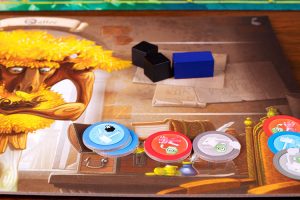
Finally, on certain actions, players will have the option to contribute blocks to the Palace construction. Each tile shows the number of cubes required from a top-down perspective. For example, if a single column of blocks is 3 cubes high, the number 3 will be shown for that column on the diagram.
On each turn, players will choose to either take blocks from the pool or complete a building. If they choose the former, they will select a pair of dice from a randomly rolled pool. If it’s the latter, they’ll take 2 tokens flipped face-up from a face-down pool. Some of these offerings not only include blocks but also other actions such as chipping off a current block (see below) or adding blocks to the palace.
During play, additional actions from bonus coins or selected dice/tokens will allow players to chip a block into two pieces or to contribute to the palace. Dividing a block is useful if the shape of the current block is not sufficient to complete a building. When choosing whether or not to contribute to the palace, players are weighing whether they make more points advancing on the palace track (1 space per cube in the polycube block size) or the polycube will be useful in a future building. Since players lose all polycubes they currently have except 1 after completing a building, using extra blocks for the palace is also a tactful expense of resources.
When a building is completed, the building tile is flipped and placed on the Village Grid. Arrows on all four sides of the tile will produce bonus coins depending on their color. If two arrows of the same color are matched, double coins are rewarded. These coins provide free actions such as adding blocks to the palace, gaining extra polycubes, or dividing polycubes. They can also just reward points as well.
After the Village Grid is filled with building tiles, the game ends and the player with the most points wins.
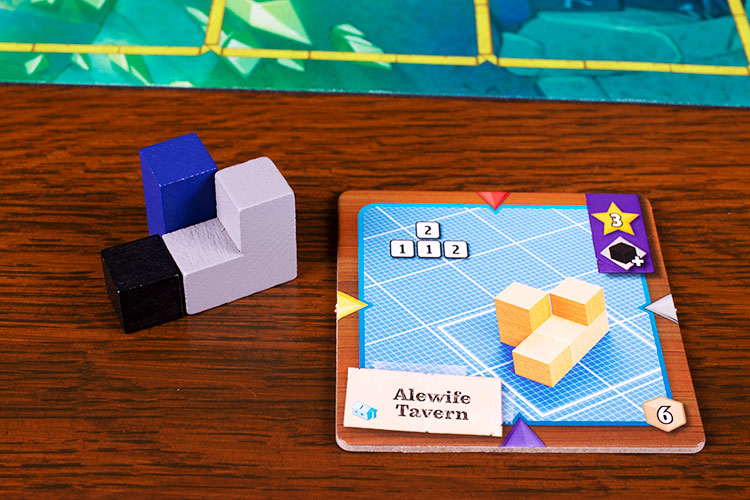
Game Experience:
If players are in the market for a polycube game, first, there isn’t much out there, and second, it’s very easy to drop a recommendation for Catacombs Cubes. Some games pride themselves on the narrow focus of their difficulty. There is none of that here. Players as young as 7 and as old as 77 will find the decisions enjoyable here. The simple building mechanisms really challenge players to think about how best to complete a building and the quickest way to do it. Larger blocks have more of a shape to contend with but smaller blocks will require more actions. There is a lot of depth in each turn’s decisions.
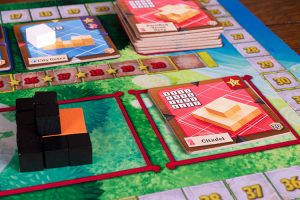
The real challenge of the game is whether or not players see those options. Younger players will have fun participating and building something given a limited resource set. Older and more competitive players will be looking for the optimal number of actions to take to complete each building. Since there are multiple ways to use the polycubes, for most buildings the challenge of action efficiency is always at the forefront. The players who remain flexible with their building options and the multiple ways to use the blocks they have will definitely do well.
If there is something to consider as a negative, it is something relatively minor. The game art and overall production are friendly with a storybook, almost Disney-esque feel. This is a big departure from the flat renders of creatures from original Catacombs. In one sense, the shading in Catacombs Cubes gives an assumably intended three-dimensional effect to the art and emphasizes the difference between the games. The word “Catacombs” in the name is the only thing connecting the two. That could be welcoming, or disappointing. For this reviewer, it’s just ok. The dark caricature art from the original Catacombs is specifically missed.
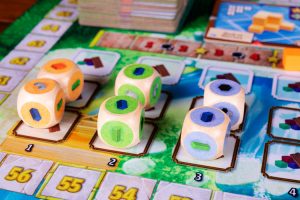
Another moment of small pause comes with the overall tension in the game. If players are happy with games that stay pretty friendly, this will fit right in. However, the general feeling is competition bordering on neutrality between fellow players. It can happen that two players are competitively racing to complete the same building, but there’s no requirement that either player has to commit to it. Therefore, the player who didn’t complete it first can quickly repurpose their cubes for another building. It’s not very cutthroat, and that’s clearly by design.
This also extends to the race to contribute to the palace. The players who compete over this can easily gain extra points, but the first to complete the palace isn’t gaining an insurmountable number of points. It’s often not an incredible game-changer, but rather a rewarding side project for blocks left over. There are plenty of points to be made from other buildings so using the palace track is there for those who choose to pursue the bonus points rather than providing a challenging contest or end-game condition.
Catacombs Cubes Monuments
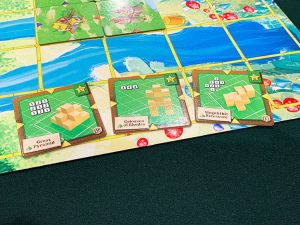
Publisher Elzra also included the Catacombs Cubes expansion titled Monuments with the review copy sent. This expansion adds challenging higher block count polycubes and Monument buildings to complete. These function like more complex buildings that award more points. These Monuments also act like residences which can be owned by a particular player and bonuses gained for others who connect to it.
The expansion also features a bigger grid and pieces for 5-6 player play. At these player counts, the downtime can be rough. With so much to choose from in the selection pool, players will need extra time to analyze what to pick. Completionists and players with large groups should get it for the extra polycubes and monuments. However, be wary of the higher player count playtime.
Final Thoughts:
For gamers who love big chunky blocks like those in Imhotep or for those who love the challenge of efficient LEGO building, Catacombs Cubes hits the spot. It’s a departure from previous titles with the Catacombs name, but it squarely fulfills the not-super-competitive family-friendly game niche. Players can each contribute buildings without fear that they will be completely shut down by more aggressive players.
Final Score: 4 stars – For those who prefer their points casual and friendly but with still some tough decisions, Catacombs Cubes is a great family-friendly building game.
 Hits:
Hits:
• Tough decisions for polycubes vs actions
• Overall game art and production quality
• Plays very well with families
Misses:
• Tile placement and drafting never feels extremely tense
• Different tone from original Catacombs






















